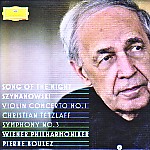There’s something strangely provincial about this production. It’s beautifully packaged, with an extra CD in which Boulez discusses–in three languages–his “discovery” of Szymanowski, and it comes with a lavish booklet that talks as much about the conductor as the composer. You would think that before Boulez got his hands on him, no one had ever heard of Szymanowski, and perhaps no one currently at DG actually has. Of course, the yellow label did record the Myths in a famous version featuring Danczowska and Zimerman, and the First Violin Concerto appeared recently on Nicola Benedetti’s debut album. Decca has the Second and Third symphonies (fine performances from Dorati) as well as the two violin concertos (Dutoit/Juillet, not so great), and EMI has been making excellent Szymanowski CDs for decades. So has Naxos, who in Antoni Wit has the best possible conductor in this repertoire.
So the question becomes this: Boulez may have more name recognition than most–though not more than Simon Rattle, whose EMI Szymanowski recordings are top-notch; but does he bring to the table uniquely powerful insights that justify the hype? Does he wipe the floor with the competition? The answer is “No”. Of course Boulez is a master musician, and there’s nothing here that’s less than good, sometimes very good–but Szymanowski is a greater master still, one with a substantial, impressive discography to his credit. This disc is not special; it’s a worthy but not outstanding effort in a well-populated and highly distinguished field.
Consider the Violin Concerto No. 1. It opens with an orchestral violin ostinato, sul ponticello, with flecks of color from the winds and percussion. All of this is crystal clear under Wit (Naxos or Sony), far less present under Boulez. Partly this is a function of the engineering, partly the less precise playing of the Vienna Philharmonic, partly the slightly too-quick initial tempo. If you don’t know one of the more than a dozen recorded alternatives, you might not notice or care, but the reality is that listeners have better options.
There are a few other anomalies too: the big climax one bar after figure 47 really isn’t together, and there are some oddities of balance (and instrumental choice) in the percussion section. At one point the tambourine part seems to be played on suspended cymbal, at least according to my score. Most importantly, Christian Tetzlaff, an excellent violinist, hasn’t quite the sexy timbre that the part requires. Much of the music lies in the violin’s highest register, and here he sounds a touch too gritty, particularly compared to, say, Danczowska (CD Accord), Kaler (Naxos), or the benchmark Wilkomirska/Rowicki (if you can find it). The big cadenza toward the end sounds distinctly gruff.
In the Third Symphony the competition is a bit less fierce, though still very strong. One of the problems in recording a composer like Szymanowski is that, although he’s not quite a household name internationally, he’s second only to Chopin in his native Poland, a country with a world-class musical infrastructure. So he’s either going to be recorded by native performers well-versed in the idiom, or specialists particularly dedicated to the cause. The result may not be an excess of versions of any given piece, but the ones we have are likely to be impressive. So it proves. Rattle’s Third Symphony, for example, is excellent, and Semkow has the best of all possible tenor soloists in Wieslaw Ochman, plus a terrific chorus. Boulez’s tenor, Steve Davislim, is good, but the chorus sounds like mush. Szymanowski asks them to vocalize much of the time, but there still ought to be a clear difference between that and where they get actual words to sing. These relative deficits aside, the performance remains a good one. Boulez handles the central march movement particularly well, and the climaxes, though a bit opaque (particularly the last one at figure 94), are suitably opulent, with the organ pedals well caught.
Is there a lesson here? Certainly no one unfamiliar with this music will be disappointed with these performances, and if “big names” are more important than “big artistry” they may well be a first choice for many. Boulez obviously cares about what DG feels it must do in the way of PR in order to justify and promote a new recording of what it evidently feels constitutes risky and unusual repertoire. Maybe Boulez even believes his own hype, but I prefer to see this more as a sign of DG’s insecurity and lack of direction as a major classical music label. There was a time when the mere fact that this music appeared on DG in the first place was all the explanation or validation required. This, after all, is what serious classical music labels theoretically do. Still, Boulez’s willingness to explore Szymanowski at such a late stage in his career can only be applauded, even if the truth is that you can do better.
































